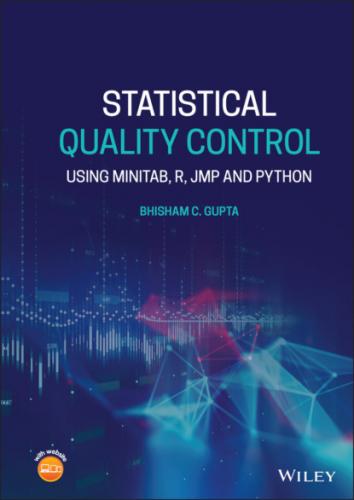Statistical Quality Control. Bhisham C. Gupta
344
339 345
340 346
341 347
342 348
343 349
344 350
345 351
346 352
347 353
348 354
349 355
350 356
351 357
352 358
353 359
354 360
355 361
356 362
357 363
358 364
359 365
360 366
361 367
362 368
363 369
364 370
365 371
Statistical Quality Control
Using Minitab, R, JMP, and Python
Bhisham C. Gupta
Professor Emeritus of StatisticsUniversity of Southern MainePortland, ME
This edition first published 2021
#169; 2021 John Wiley & Sons, Inc.
All rights reserved. No part of this publication may be reproduced, stored in a retrieval system, or transmitted, in any form or by any means, electronic, mechanical, photocopying, recording or otherwise, except as permitted by law. Advice on how to obtain permission to reuse material from this title is available at http://www.wiley.com/go/permissions.
The right of Bhisham C. Gupta to be identified as the author of this work has been asserted in accordance with law.
Registered Office John Wiley & Sons, Inc., 111 River Street, Hoboken, NJ 07030, USA
Editorial Office 111 River Street, Hoboken, NJ 07030, USA
For details of our global editorial offices, customer services, and more information about Wiley products visit us at www.wiley.com.
Wiley also publishes its books in a variety of electronic formats and by print‐on‐demand. Some content that appears in standard print versions of this book may not be available in other formats.
Limit of Liability/Disclaimer of Warranty While the publisher and authors have used their best efforts in preparing this work, they make no representations or warranties with respect to the accuracy or completeness of the contents of this work and specifically disclaim all warranties, including without limitation any implied warranties of merchantability or fitness for a particular purpose. No warranty may be created or extended by sales representatives, written sales materials or promotional statements for this work. The fact that an organization, website, or product is referred to in this work as a citation and/or potential source of further information does not mean that the publisher and authors endorse the information or services the organization, website, or product may provide or recommendations it may make. This work is sold with the understanding that the publisher is not engaged in rendering professional services. The advice and strategies contained herein may not be suitable for your situation. You should consult with a specialist where appropriate. Further, readers should be aware that websites listed in this work may have changed or disappeared between when this work was written and when it is read. Neither the publisher nor authors shall be liable for any loss of profit or any other commercial damages, including but not limited to special, incidental, consequential, or other damages.
Library of Congress Cataloging‐in‐Publication Data ISBN 978‐1‐119‐67163‐3 (hardback) ISBN 978‐1‐119‐67170‐1 (ePDF) ISBN 978‐1‐119‐67172‐5 (ePub) ISBN 978‐1‐119‐67171‐8 (oBook)
Cover image:
Cover design by
In loving memory of my parents, Roshan Lal and Sodhan Devi
Preface
This is an introductory textbook on statistical quality control (SQC), an important part of applied statistics that is used regularly to improve the quality of products throughout manufacturing, service, transportation, and other industries. The objective of this book is to provide a basic but sound understanding of how to apply the various techniques of SQC to improve the quality of products in various sectors. Knowledge of statistics is not a prerequisite for using this text. Also, this book does not assume any knowledge of calculus. However, a basic knowledge of high school algebra is both necessary and sufficient to grasp the material presented in this book.
Various concepts of the Six Sigma methodology are also discussed. Six Sigma methodology calls for many more statistical tools than are reasonable to address in one book; accordingly, the intent here is to provide Six Sigma team members with some basic statistical concepts, along with an extensive discussion of SQC tools in a way that addresses both the underlying statistical concepts and their applications.
Audience
This book is written for second‐year or third‐year college/university students who are enrolled in engineering or majoring in statistics, management studies, or any other related field, and are interested in learning various SPC techniques. The book can also serve as a desk reference for practitioners who work to improve quality in sectors such as manufacturing, service, transportation, medical, oil, and financial institutions, or for those who are using Six Sigma techniques to improve the quality of products in such areas. This book will also serve those who are preparing for certification in Six Sigma training, such as the Six Sigma Green Belt. In the Western world, these kinds of certifications are very common, particularly in the manufacturing, service, transportation, medical, and oil industries.
Topics Covered in This Book
In Chapter 1, we introduce the basic concept of quality, as discussed by various pioneer statisticians, engineers, and practitioners. A few important pioneers in this area are W. Edwards Deming, Joseph M. Juran, Philip B. Crosby, and Armand V. Feigenbaum. Concepts of quality control and quality improvements are discussed. Finally, we discuss how management can help improve product quality.
In Chapter 2, we introduce the Six Sigma methodology.
